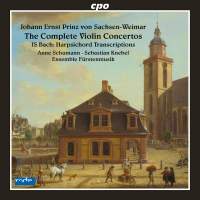Texte paru dans: / Appeared in: |
|
|
Outil de traduction ~ (Très approximatif) |
|
|
Reviewer: Robert
Maxham Violinist Anne Schumann and the Ensemble Fürsten-Musik have assembled the eight violin concertos written by the youthful Prince Johann Ernst of Sachsen-Weimar and transcriptions of three of them for harpsichord by Johann Sebastian Bach (BWV 592a, BWV 982, and BWV 987). Their program opens with the Prince’s First Concerto, in E Major. The thorough booklet notes by musicologist Manfred Fechner, who assisted with the project, provide an exceedingly detailed historical study of the circumstances of the works’ composition, their publication (with the support of Georg Philipp Telemann), and the transcriptions by Bach. Fechner mentions the influence of Antonio Vivaldi, and it can be heard right away in the Fifth Concerto’s Siciliana, reminiscent of the similarly titled movement of Vivaldi’s Concerto, op. 3/11, although Fechner focuses in his notes on the style of the violinistic passagework. The Fourth Concerto, in D Minor, opens with a bold motive, Adagio e staccato, recalling similar rhetoric in Vivaldi’s same concerto; but Anne Schumann lets the violin figuration run fleetly after the commanding orchestral outburst. Sebastian Knebel makes Bach’s transcription of this concerto for harpsichord—as do the composer’s similar arrangements of Vivaldi—heighten the expressivity and sense of fancy; but in this case, Knebel also make the first movement’s passagework sound especially brilliant. That no more denigrates the Prince’s youthful élan than it does Vivaldi’s heady forward movement—in both cases something has been lost while other things have been gained (it may even be possible to suggest that Bach didn’t drink from the wellsprings of Vivaldi’s creativity but preferred his own). The program continues with the Prince’s Seventh Concerto in G Major and the Third in E Minor (a three-movement work in which two effervescent fast movements sandwich a Pastorale replete with pedal tones; in these a second solo violin joins Schumann). The First Concerto, in B♭ Major, served as another source for one of Bach’s transcriptions, although some may feel that this work didn’t call forth from Bach a level of inspiration as high as that exhibited in his transcription of the Concerto in D Minor. The Ernst program continues with the Second Concerto, in A Minor, another in three-movements, centered on a Largo provided with an arch staccato accompaniment, which the Ensemble plays with spiky wit. The Eighth Concerto in G Major provided Bach a third original for transcription. The first movement of Ernst’s work bubbles over in the Ensemble’s performance, with a second violin discreetly joining in during the second movement. Bach hardly diminished the first movement’s exuberance, arguably adds weight to the second, and preserves the excitement of the third. The program concludes with the Prince’s Sixth Concerto in G Minor, featuring a slow movement, “Recitativo,” that leaves listeners wondering what Bach might have made of it, as well as a fugal finale reminiscent of the big fugue in Vivaldi’s op. 3/11. Throughout, Schumann and the Ensemble (and Knebel in the transcriptions) impart to the music a heady forward motion, enhanced by CPO’s spacious and clear recorded sound in St. Bartholomew’s Church in Blankenburg. The timbres should accommodate those who prefer either a “period” sound or a more modern-oriented one, while the pitch, at A=415, never sinks the musical ship it floats. For its historical interest, for the insight it provides into Bach’s procedures as a transcriber, and hardly least for the high quality and ingratiating manner of the Prince’s concertos themselves, CPO’s release deserves an enthusiastic commendation. | |
|
|
|
|
Cliquez l'un ou l'autre
bouton pour découvrir bien d'autres critiques de CD |
|




